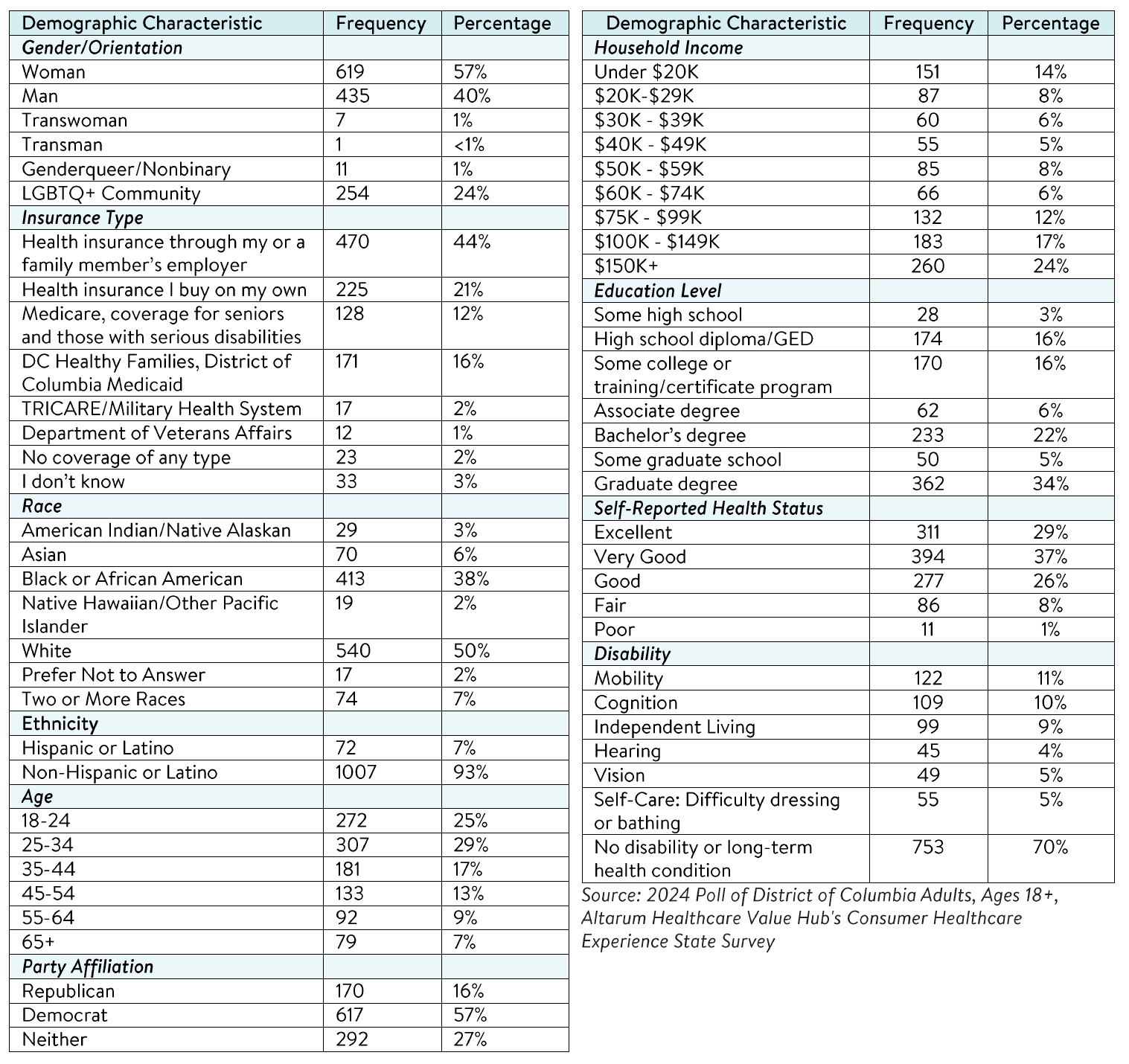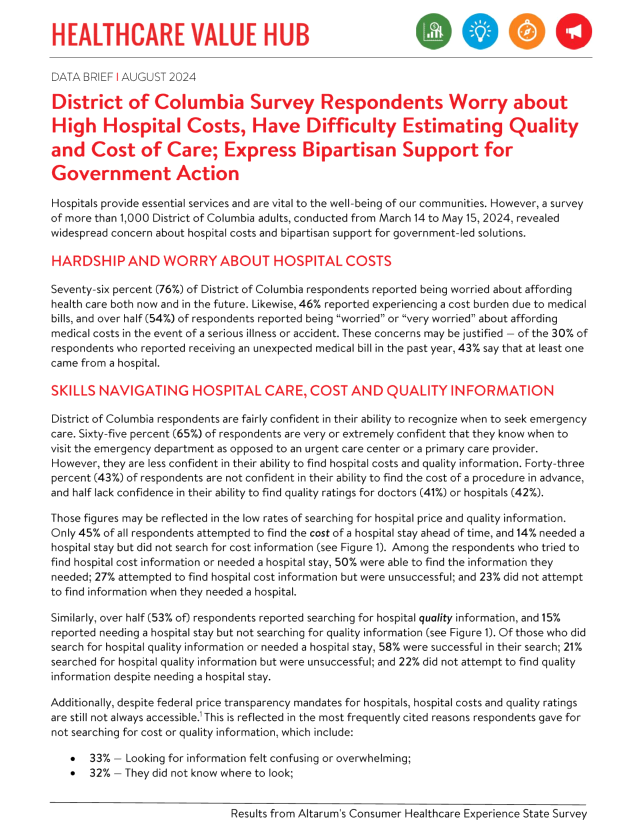District of Columbia Survey Respondents Worry about High Hospital Costs, Have Difficulty Estimating Quality and Cost of Care; Express Bipartisan Support for Government Action
Hospitals provide essential services and are vital to the well-being of our communities. However, a survey
of more than 1,000 District of Columbia adults, conducted from March 14 to May 15, 2024, revealed
widespread concern about hospital costs and bipartisan support for government-led solutions.
Hardship and Worry About Hospital Costs
Seventy-six percent (76%) of District of Columbia respondents reported being worried about affording
health care both now and in the future. Likewise, 46% reported experiencing a cost burden due to medical
bills, and over half (54%) of respondents reported being "worried" or "very worried" about affording
medical costs in the event of a serious illness or accident. These concerns may be justified — of the 30% of respondents who reported receiving an unexpected medical bill in the past year, 43% say that at least one came from a hospital.
Skills Navigating Hospital Care, Cost and Quality Information
District of Columbia respondents are fairly confident in their ability to recognize when to seek emergency
care. Sixty-five percent (65%) of respondents are very or extremely confident that they know when to
visit the emergency department as opposed to an urgent care center or a primary care provider.
However, they are less confident in their ability to find hospital costs and quality information. Forty-three
percent (43%) of respondents are not confident in their ability to find the cost of a procedure in advance,
and half lack confidence in their ability to find quality ratings for doctors (41%) or hospitals (42%).
Those figures may be reflected in the low rates of searching for hospital price and quality information.
Only 45% of all respondents attempted to find the cost of a hospital stay ahead of time, and 14% needed a hospital stay but did not search for cost information (see Figure 1). Among the respondents who tried to
find hospital cost information or needed a hospital stay, 50% were able to find the information they
needed; 27% attempted to find hospital cost information but were unsuccessful; and 23% did not attempt
to find information when they needed a hospital.
Similarly, over half (53% of) respondents reported searching for hospital quality information, and 15%
reported needing a hospital stay but not searching for quality information (see Figure 1). Of those who did
search for hospital quality information or needed a hospital stay, 58% were successful in their search; 21% searched for hospital quality information but were unsuccessful; and 22% did not attempt to find quality information despite needing a hospital stay.
Additionally, despite federal price transparency mandates for hospitals, hospital costs and quality ratings
are still not always accessible.1 This is reflected in the most frequently cited reasons respondents gave for
not searching for cost or quality information, which include:
- 33% — Looking for information felt confusing or overwhelming;
- 32% — They did not know where to look;
- 29% — They followed their doctors' recommendations or referrals;
- 24% — They did not have time to look; and
- 18% — It did not occur to them to look for provider quality or price information.
Notably, a small number of respondents reported that cost or quality is not important to them (13% and
8%, respectively).

Respondents who were unsuccessful in their search for hospital cost information described several
challenges. Forty-one percent reported that their provider or hospital would not provide a price estimate;
40% reported that their insurer would not provide a price estimate; (38%) reported that the available cost
information was confusing and 26% reported that the price information was insufficient. Likewise, among
respondents who were unsuccessful in their search for hospital quality information, 26% reported that the
resources were confusing, and 23% reported that the quality information was not sufficient.
However, among those who were successful in their search for cost or quality information, 64% reported
they were able to find enough information to successfully compare the costs of a hospital stay between
two or more options, and 69% reported finding enough information to compare quality ratings across
hospitals (see Figure 2). Many of these respondents reported that the comparison ultimately influenced
their choice of which provider to seek care from. Eighty-eight percent (88%) of respondents who
compared the cost of a primary care or specialist doctor visit, 83% of those who compared the cost of
medical test and 91% of those who compared the cost of a hospital stay reported that the comparison
influenced their choice of hospital or provider. Likewise, 91% of respondents who searched for hospital
quality information reported that the comparison influenced their decision of hospital.
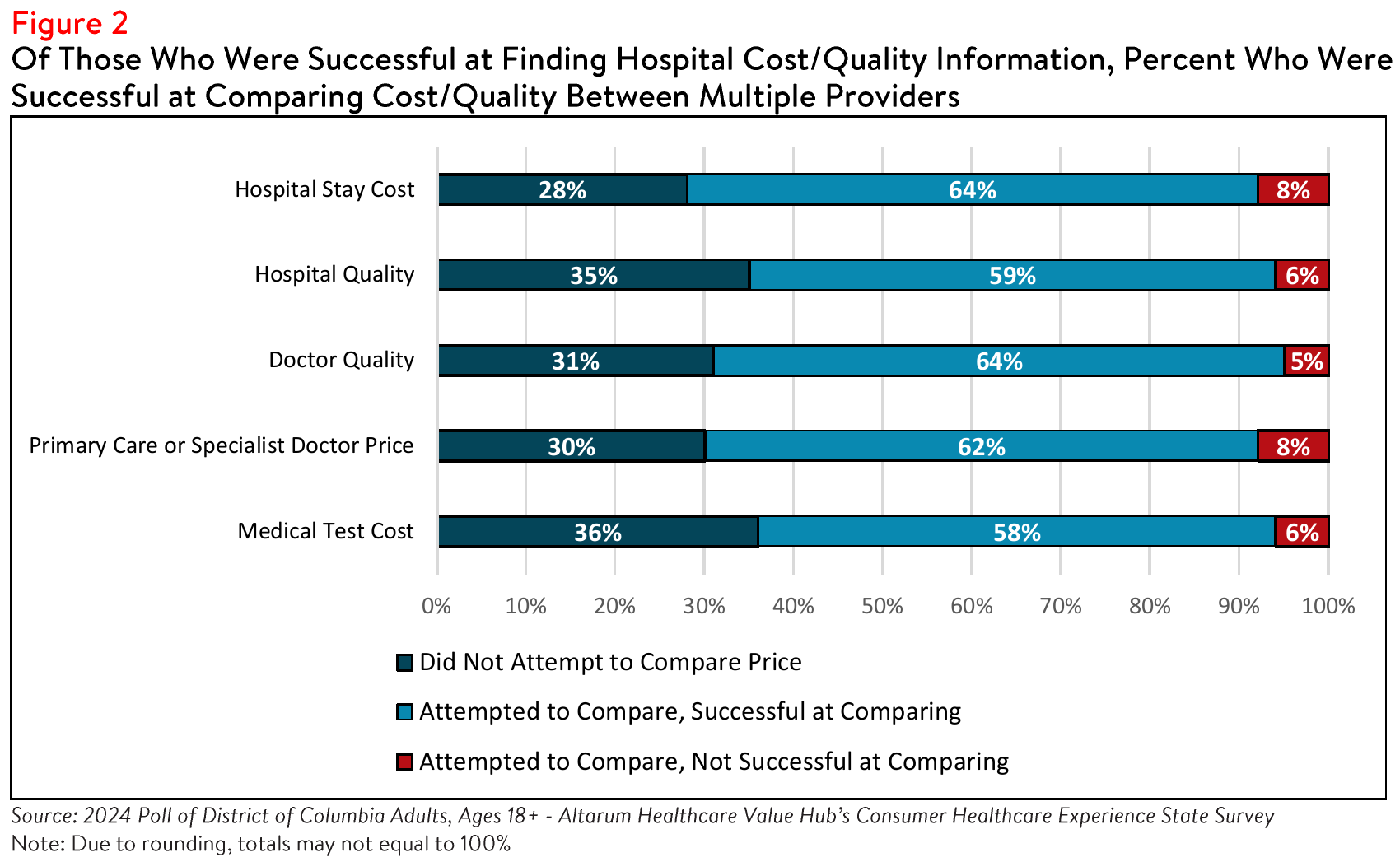
Impact of and Worry Related to Hospital Consolidation
In addition to the above health care affordability burdens, a small share of District of Columbia
respondents reported being negatively impacted by health system consolidation.
District of Columbia does not require that the State Attorney General be notified of hospital
transactions.2 However, the state does have approval authority for all transactions involving nonprofit
hospitals only.
In the past year, 35% of respondents reported that they were aware of a merger or acquisition in their
community—of those respondents, 41% reported that they or a family member were unable to access
their preferred health care organization because of a merger that made their preferred organization outof-
network. Out of those who reported being unable to access their preferred health care provider due to
a merger:
- 62% — delayed or avoided going to the doctor or having a procedure done because they could no longer access their preferred health care organization due to a merger;
- 31% — skipped filling a prescription medication;
- 28% — skipped recommended follow-up visits due to a merger;
- 22% — changed their health plan coverage to include the preferred doctor or hospital;
- 19% — have switched to telehealth options to continue seeing their preferred provider;
- 17% — changed their preferred doctor or hospital to one that is in-network;
- 17% —stayed with their preferred health care provider and now pay out-of-network prices; and
- 10% — have changed their preferred provider due to a merger resulting in a service closure.
Out of those who reported that the merger caused an additional burden for them or their families, the top
three most frequently reported issues were:
- 38% — The merger created an added wait time when searching for a new provider
- 23% — The merger created an added financial burden
- 18% — The merger created a gap in the continuity of my care
While a portion of respondents reported being unable to access their preferred health care organization
because of a merger, respondents also (66%) reported being somewhat, moderately or very worried
about the impacts of mergers in their health care organizations. When asked about their largest concern
respondents most frequently reported:
- 27%— I'm concerned I will have fewer choices of where to receive care
- 24%— I'm concerned I will have to pay more to see my doctor
- 22%— I'm concerned my doctor may no longer be covered by my insurance
- 14%— I'm concerned I will have to travel farther to see my doctor
- 13%— I'm concerned I will have a lower quality of care
To ascertain additional information on the specific ways that health system consolidation impacts District
of Columbia residents, survey respondents were asked to share their experiences following hospital
consolidation (see Table 1).
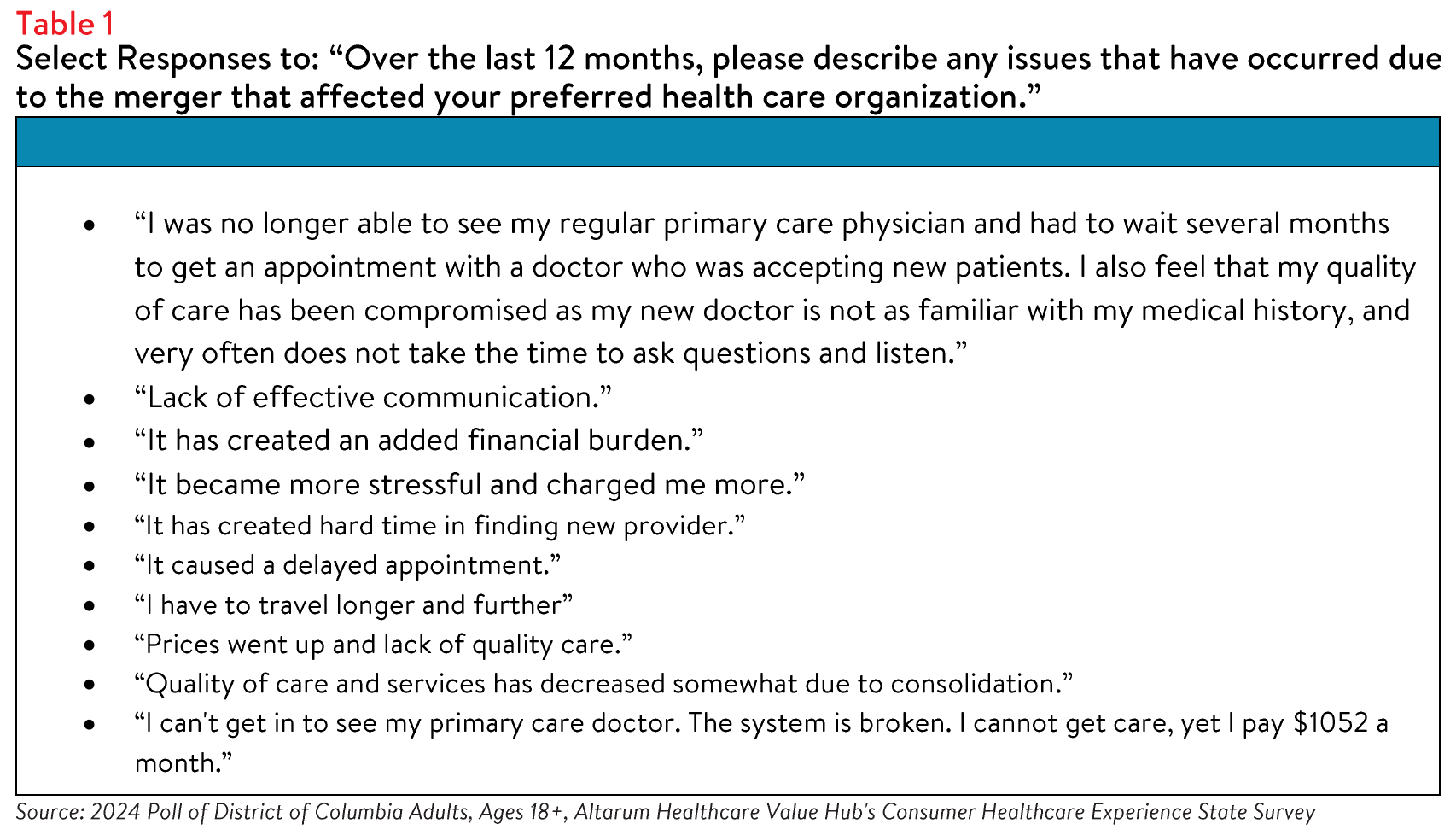
Support for Solutions Across Party Lines
Hospitals, along with drug manufacturers and insurance companies, are viewed as a primary contributor to high health care costs. Out of fifteen possible options, District of Columbia respondents most frequently
reported believing that the reason for high health care costs is unfair prices charged by powerful industry
stakeholders, such as:
- 63% — Drug companies charging too much money
- 61% — Hospitals charging too much money
- 61% — Insurance companies charging too much money
- 51% — Large hospitals or physician groups using their influence to increase payments from insurance companies
Respondents endorsed a number of strategies to address high health care costs, including:
- 89%— Require hospitals and doctors to provide up-front cost estimates to consumers;
- 86%— Impose price controls on contracts between insurers and health care providers;
- 86%— Strengthen policies to drive more competition in health care markets;
- 85%— Set standard payments to hospitals for specific procedures; and
- 85%— Establish an independent entity to rate doctor and hospital quality.
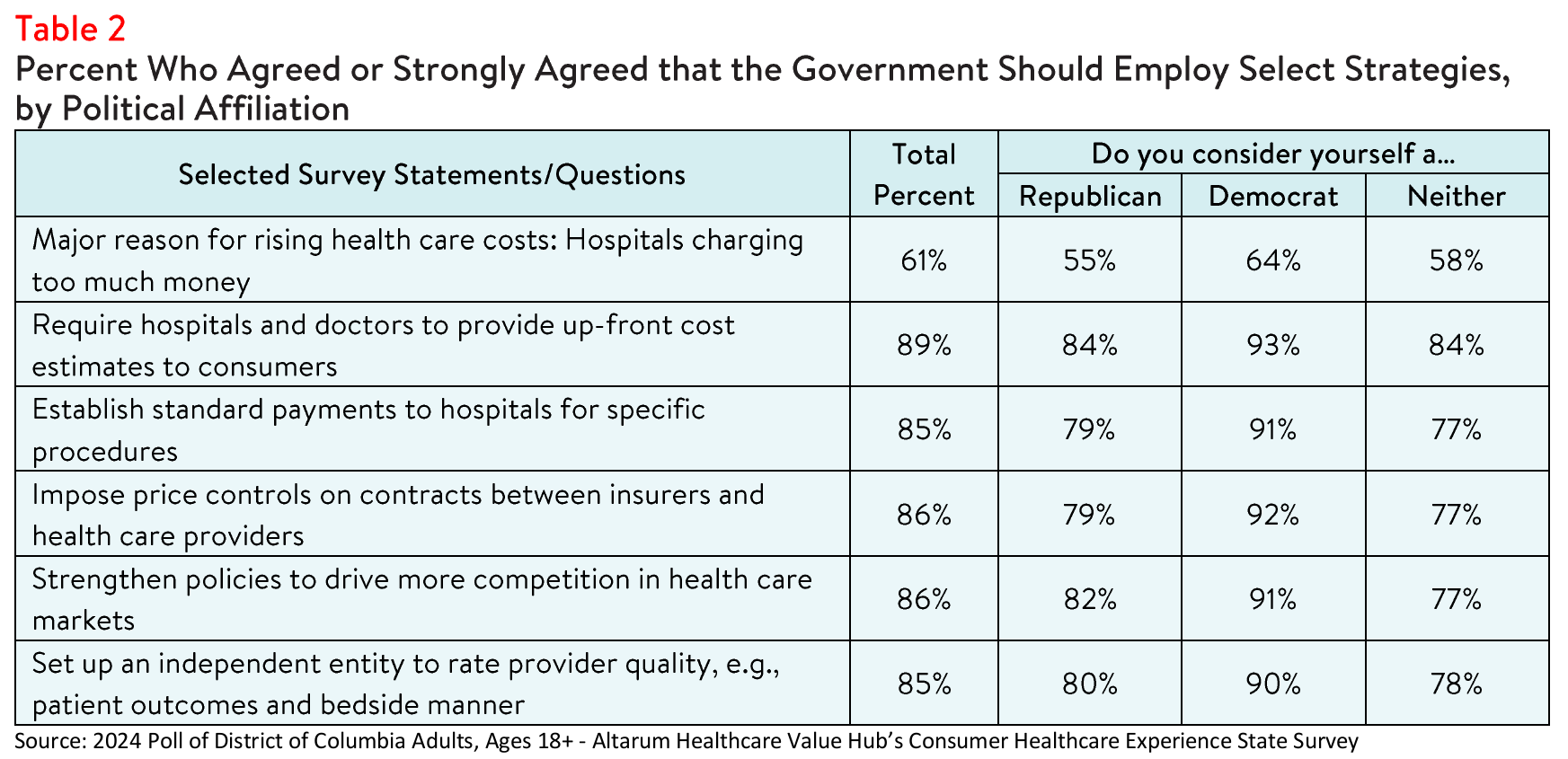
Conclusion
The poll findings indicate that while some District of Columbia respondents are motivated to search for
hospital cost and quality information to inform their decisions and plan for future medical expenses, close
to half did not seek this information at all. This suggests that price transparency initiatives alone may not
effectively influence consumer behavior. Unfortunately, the lack of knowledge of hospital quality and
potential costs may impede District of Columbia residents' ability to plan for needed care and budget for
the expense of a hospital stay, which can be costly, particularly for residents who are uninsured or underinsured.3
District of Columbia respondents support government-led solutions to make price and quality information
more accessible and to help consumers navigate hospital care. Many favored solutions could reduce the
burden on consumers, such as standardizing payments for specific procedures, requiring cost estimates
from hospitals and doctors, and establishing an independent entity for quality reviews. Policymakers
should consider these and other policy options to address the bipartisan call for government action.
Notes
-
As of January 1, 2021, the Centers for Medicare and Medicaid Services (CMS) requires hospitals to make public a
machine-readable file containing a list of standard charges for all items and services provided by the hospital, as well as a consumer-friendly display of at least 300 shoppable services that a patient can schedule in advance. However, Compliance from hospitals has been mixed, indicating that the rule has yet to demonstrate the desired effect. https://www.healthaffairs.org/content/forefront/hospital-price-transparency-progress-and-commitment-achieving-itspotential -
The Source on Health Care Price and Competition, Merger Review, Retrieved July15, 2024 from
https://sourceonhealth care.org/market-consolidation/merger-review/ -
According to Health Forum, an affiliate of the American Hospital Association, hospital adjusted expenses per inpatient day in District of Columbia were $4,068 in 2022, similar to the national average. See: Kaiser Family Foundation, State Health Facts Data: Hospital Adjusted Expenses per Inpatient Day. Accessed July 15, 2024. https://www.kff.org/healthcosts/state-indicator/expenses-per-inpatient-day/
Methodology
Altarum's Consumer Healthcare Experience State Survey (CHESS) is designed to elicit respondents' views on a wide range of health system issues, including confidence using the health system, financial burden and possible policy solutions. This survey, conducted from March 14 to May 15, 2024, used a web panel from Dynata with a demographically balanced sample of approximately 1,180 respondents who live in District of Columbia. Information about Dynata's recruitment and compensation methods can be found here. The survey was conducted in English or Spanish and restricted to adults ages 18 and older.
Respondents who finished the survey in less than half the median time were excluded from the final sample, leaving 1,079 cases for analysis. After those exclusions, the demographic composition of respondents was as follows, although not all demographic information has complete response rates:
